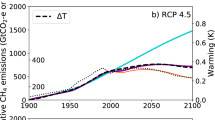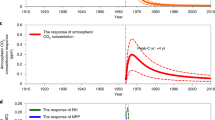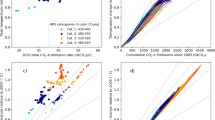Abstract
Globally, CO2 and other long-lived greenhouse gas emissions are key components that affect climate, but some of the more shorter-lived air pollutants also either warm or cool the climate on timescales depending on the species. Therefore, emission reduction policies from a climate perspective need to take into account the net effect of multiple pollutants (UNEP/WMO, 2011; Stohl et al., 2015). The pollutants considered to have most climate relevance are termed short-lived climate pollutants (SLCPs) or short-lived climate forcers (SLCFs), depending on the context. For example, the Intergovernmental Panel on Climate Change’s (IPCC) special report Global Warming of 1.5 C (IPCC, 2019) defined SLCFs to refer to both cooling and warming species that include methane (CH4), ozone (O3) and aerosols (including, black carbon, BC, organic carbon, OC, and sulfate) or their precursors, as well as some halogenated species. SLCPs refer only to the warming SLCFs (IPCC, 2019).
Access this chapter
Tax calculation will be finalised at checkout
Purchases are for personal use only
Similar content being viewed by others
References
Amann, M., Bertok, I., Borken-Kleefeld, J., Cofala, J., Heyes, C., Höglund-Isaksson, L., Klimont, Z., Nguyen, B., Posch, M., Rafaj, P., Sandler, R., Schöpp, W., Wagner, F., & Winiwarter, W. (2011). Cost-effective control of air quality and greenhouse gases in Europe: Modeling and policy applications. Environmental Modelling & Software, 26, 1489–1501.
AMAP. (2008a). AMAP/Quinn et al., 2008, The impact of short-lived pollutants on arctic climate (AMAP technical report No. 1) (23 p). Arctic Monitoring and Assessment Programme (AMAP). https://www.amap.no/documents/doc/the-impact-of-short-lived-pollutants-on-arctic-climate/15
AMAP. (2008b). AMAP/Bluestein et al., 2008, Sources and mitigation opportunities to reduce emissions of short-term arctic climate forcers (AMAP technical report No. 2) (8 p). Arctic Monitoring and Assessment Programme (AMAP). https://www.amap.no/documents/doc/sources-and-mitigation-opportunities-to-reduce-emissions-of-short-term-arctic-climate-forcers/13
AMAP. (2011). In P. K. Quinn, A. Stohl, A. Arneth, T. Berntsen, J. F. Burkhart, J. Christensen, M. Flanner, K. Kupiainen, H. Lihavainen, M. Shepherd, V. Shevchenko, H. Skov, & V. Vestreng (Eds.), The impact of black carbon on Arctic climate. Arctic Monitoring and Assessment Programme (AMAP). 72 pp. ISBN 978-82-7971-069-1.
AMAP. (2017). Snow, Water, Ice and Permafrost in the Arctic (SWIPA), Arctic Monitoring and Assessment Programme (AMAP), Oslo, Norway. xiv + 269 pp. ISBN 978-82-7971-101-8.
AMAP Assessment. (2015a). Black carbon and ozone as Arctic climate forcers. Arctic Monitoring and Assessment Programme (AMAP). vii + 116 pp. ISBN 978-82-7971-092-9.
AMAP Assessment. (2015b). Methane as an Arctic climate forcer. Arctic Monitoring and Assessment Programme (AMAP). vii + 139 pp. ISBN 978-82-7971-091-2.
AMAP Assessment. (2021). Impacts of short-lived climate forcers on Arctic climate, air quality, and human health. Arctic Monitoring and Assessment Programme (AMAP). In press.
Arctic Council. (2015). Annex 4. Iqaluit 2015 Sao report to ministers. Enhanced black carbon and methane emissions reductions. An Arctic Council Framework for Action. Available at: https://oaarchive.arctic-council.org/handle/11374/610. Last access: 18 Dec 2020.
Arctic Council. (2017). Expert group on black carbon and methane; summary of progress and recommendations. Available at: https://oaarchive.arctic-council.org/handle/11374/1936. Last access: 18 Dec 2020.
Arctic Council. (2019). Expert group on black carbon and methane; summary of progress and recommendations 2019, available at: https://oaarchive.arctic-council.org/handle/11374/2411. Last access: 18 Dec 2020.
Barrie, L. A. (1986). Arctic air-pollution – An overview of current knowledge. Atmospheric Environment, 20(4), 643–663.
Christensen, T. R., Arora, V. K., Gauss, M., Höglund-Isaksson, L., & Parmentier, F.-J. W. (2019). Tracing the climate signal: Mitigation of anthropogenic methane emissions can outweigh a large Arctic natural emission increase. Scientific Reports, 9, 1146. https://doi.org/10.1038/s41598-018-37719-9
Eckhardt, S., Quennehen, B., Olivié, D. J. L., Berntsen, T. K., Cherian, R., Christensen, J. H., Collins, W., Crepinsek, S., Daskalakis, N., Flanner, M., Herber, A., Heyes, C., Hodnebrog, Ø., Huang, L., Kanakidou, M., Klimont, Z., Langner, J., Law, K. S., Lund, M. T., Mahmood, R., Massling, A., Myriokefalitakis, S., Nielsen, I. E., Nøjgaard, J. K., Quaas, J., Quinn, P. K., Raut, J. C., Rumbold, S. T., Schulz, M., Sharma, S., Skeie, R. B., Skov, H., Uttal, T., von Salzen, K., & Stohl, A. (2015). Current model capabilities for simulating black carbon and sulfate concentrations in the Arctic atmosphere: A multi-model evaluation using a comprehensive measurement data set. Atmospheric Chemistry and Physics, 15(16), 9413–9433. https://doi.org/10.5194/acp-15-9413-2015
Etminan, M., Myhre, G., Highwood, E. J., & Shine, K. P. (2016). Radiative forcing of carbon dioxide, methane, and nitrous oxide: A significant revision of the methane radiative forcing. Geophysical Research Letters, 43, 12,614–12,623. https://doi.org/10.1002/2016GL071930
Evangeliou, N., Kylling, A., Eckhardt, S., Myroniuk, V., Stebel, K., Paugam, R., Zibtsev, S., & Stohl, A. (2019). Open fires in Greenland in summer 2017: Transport, deposition and radiative effects of BC, OC and BrC emissions. Atmospheric Chemistry and Physics, 19, 1393–1411. https://doi.org/10.5194/acp-19-1393-2019
Flanner, M. G., Gardner, A. S., Eckhardt, S., Stohl, A., & Perket, J. (2014). Aerosol radiative forcing from the 2010 Eyjafjallajökull volcanic eruptions. Journal of Geophysical Research: Atmospheres, 119, 9481–9491. https://doi.org/10.1002/2014JD021977
Gothenburg Protocol. (1999). Protocol to the 1979 CLRTAP to abate acidification, eutrophication and ground-level ozone (adopted 30 November 1999, entered into force 17 May 2005) 2319 UNTS 81.
IPCC. (2014). In Core Writing Team, R. K. Pachauri, & L. A. Meyer (Eds.), Climate change 2014: Synthesis report. Contribution of working groups I, II and III to the fifth assessment report of the intergovernmental panel on climate change (151 pp). IPCC.
IPCC (2019). Annex I: Glossary. In V. Masson-Delmotte, P. Zhai, H.-O. Pörtner, D. Roberts, J. Skea, P. R. Shukla, A. Pirani, W. Moufouma-Okia, C. Péan, R. Pidcock, S. Connors, J. B. R. Matthews, Y. Chen, X. Zhou, M. I. Gomis, E. Lonnoy, T. Maycock, M. Tignor, & T. Waterfield (Eds.), Global warming of 1.5 C. an IPCC special report on the impacts of global warming of 1.5 C above pre-industrial levels and related global greenhouse gas emission pathways, in the context of strengthening the global response to the threat of climate change, sustainable development, and efforts to eradicate poverty. Intergovernmental Panel on Climate Change.
Khan, A. (2016). The global commons through a regional Lens: The Arctic council on short-lived climate pollutants. Transnational Environmental Law, 1–22. https://doi.org/10.1017/S2047102516000157
Khan, A., & Kulovesi, K. (2018). Black carbon and the Arctic: Global problem-solving through the nexus of science, law and space. Review of European, Comparative & International Environmental Law, 27, 5–14. https://doi.org/10.1111/reel.12245
McCarty et al. (2021). https://bg.copernicus.org/articles/18/5053/2021/bg-18-5053-2021.pdf
Miller, R.L. & Tegen, I. (1998). Climate response to soil dust aerosols. Journal of Climate, 11, 3247–3267.
Myhre, G., Shindell, D., Bréon, F.-M., Collins, W., Fuglestvedt, J., Huang, J., Koch, D., Lamarque, J.-F., Lee, D., Mendoza, B., Nakajima, T., Robock, A., Stephens, G., Takemura, T., & Zhang, H. (2013). Anthropogenic and natural radiative forcing. In T. F. Stocker, D. Qin, G.-K. Plattner, M. Tignor, S. K. Allen, J. Boschung, A. Nauels, Y. **a, V. Bex, & P. M. Midgley (Eds.), Climate change 2013: The physical science basis. Contribution of working group I to the fifth assessment report of the intergovernmental panel on climate change. Cambridge University Press.
OECD. (2021). The economic benefits of air quality improvements in Arctic council countries. OECD Publishing.
Rogelj, J., Schaeffer, M., Meinshausen, M., Shindell, D. T., Hare, W., Klimont, Z., Velders, G. J. M., Amann, M., & Schellnhuber, H. J. (2014). Disentangling the effects of CO2 and short-lived climate forcer mitigation. Proceedings of the National Academy of Sciences of the United States of America (PNAS), 111(46), 16325–16330. https://doi.org/10.1073/pnas.1415631111
Sand, M., Berntsen, T. K., von Salzen, K., Flanner, M. G., Langner, J., & Victor, D. G. (2016). Response of Arctic temperature to changes in emissions of short-lived climate forcers. Nature Climate Change, 6, 286–290. https://doi.org/10.1038/nclimate2880
Shindell, D., Kuylenstierna, J. C. I., Vignati, E., van Dingenen, R., Amann, M., Klimont, Z., Anenberg, S. C., Muller, N., Janssens-Maenhaut, G., Raes, F., Schwartz, J., Faluvegi, G., Pozzoli, L., Kupiainen, K., Höglund-Isaksson, L., Emberson, L., Streets, D., Ramanathan, V., Hicks, K., Kim Oanh, N. T., Milly, G.,Williams, M., Demkine, W., & Fowler, D. (2012). Simultaneously mitigating near-term climate change and improving human health and food security. Science, 335, 183–189. https://doi.org/10.1126/science.1210026
Shindell, D., Borgford-Parnell, N., Brauer, M., Haines, A., Kuylenstierna, J. C. I., Leonard, S. A., Ramanathan, V., Ravishankara, A., Amann, M., & Srivastava, L. (2017). A climate policy pathway for near- and long-term benefits. Science, 356, 493–494. https://doi.org/10.1126/science.aak9521
Stohl, A., Berg, T., Burkhart, J. F., Fjaeraa, A. M., Forster, C., Herber, A., Hov, Ø., Lunder, C., McMillan, W. W., Oltmans, S., Shiobara, M., Simpson, D., Solberg, S., Stebel, K., Stroem, J., Torseth, K., Treffeisen, R., Virkkunen, K., & Yttri, K. E. (2007). Arctic smoke – Record high air pollution levels in the European Arctic due to agricultural fires in Eastern Europe. Atmospheric Chemistry and Physics, 7, 511–534.
Stohl, A., Aamaas, B., Amann, M., Baker, L. H., Bellouin, N., Berntsen, T. K., Boucher, O., Cherian, R., Collins, W., Daskalakis, N., Dusinska, M., Eckhardt, S., Fuglestvedt, J. S., Harju, M., Heyes, C., Hodnebrog, Ø., Hao, J., Im, U., Kanakidou, M., Klimont, Z., Kupiainen, K., Law, K. S., Lund, M. T., Maas, R., MacIntosh, C. R., Myhre, G., Myriokefalitakis, S., Olivié, D., Quaas, J., Quennehen, B., Raut, J.-C., Rumbold, S. T., Samset, B. H., Schulz, M., Seland, Ø., Shine, K. P., Skeie, R. B., Wang, S., Yttri, K. E., & Zhu, T. (2015). Evaluating the climate and air quality impacts of short-lived pollutants. Atmospheric Chemistry and Physics, 15, 10529–10566. https://doi.org/10.5194/acp-15-10529-2015
UNEP & WMO (2011). Integrated assessment of black carbon and tropospheric ozone: Summary for decision makers. 30 p. ISBN: 978-92-807-3142-2. Available at: http://wedocs.unep.org/handle/20.500.11822/8028.
Author information
Authors and Affiliations
Corresponding author
Editor information
Editors and Affiliations
Rights and permissions
Copyright information
© 2022 The Author(s), under exclusive license to Springer Nature Switzerland AG
About this chapter
Cite this chapter
Kupiainen, K., Flanner, M., Eckhardt, S. (2022). Climate Effects of Other Pollutants – Short-Lived Climate Forcers and the Arctic. In: Finger, M., Rekvig, G. (eds) Global Arctic. Springer, Cham. https://doi.org/10.1007/978-3-030-81253-9_9
Download citation
DOI: https://doi.org/10.1007/978-3-030-81253-9_9
Published:
Publisher Name: Springer, Cham
Print ISBN: 978-3-030-81252-2
Online ISBN: 978-3-030-81253-9
eBook Packages: Earth and Environmental ScienceEarth and Environmental Science (R0)




